Eleusis › Veii » Ancient origins
Articles and Definitions › Contents
- Eleusis › Antique Origins
- Veii › Ancient History
Ancient civilizations › Historical and archaeological sites
Eleusis › Antique Origins
Definition and Origins
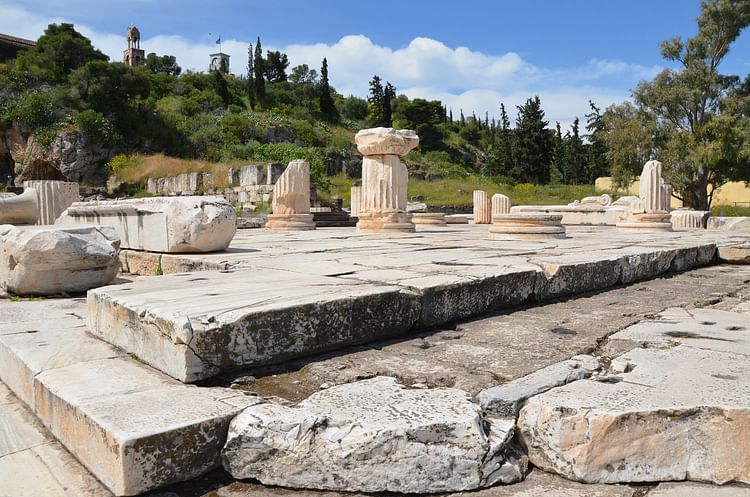
Eleusis was a deme of Athens and most famous for its annual festival of the Mysteries in honour of Demeter and Persephone. The site was also an important fortress protecting Attica and held several other important festivals, notably the Thesmophoria, the subject and title of a comedy play by Aristophanes. The site continued to be an important religious centre through Hellenistic and Roman times, when the site was significantly expanded with monumental architecture being added by several Roman emperors.
ELEUSIS IN MYTHOLOGY
In Greek mythology when Demeter was searching for her daughter Persephone, who had been abducted by Hades, she decided to rest from her weary quest at Eleusis. The daughters of the king, Celeus, offered to help the goddess who was disguised as an old woman. Recuperating in the royal palace, Demeter took a shine to Celeus' infant son Demophon (or Triptolemus) to whom she gave ambrosia and, each night in secret, she held the youth over a fire in order to make him immortal. Demophon's mother happened to see this one night and, misunderstanding the goddess' intentions, banished the old woman from the palace. Not best pleased, Demeter revealed her true identity and ordered Celeus to build her a temple.This was done, and the goddess retreated inside it and brought a terrible drought and famine upon the land, until the other Olympian gods revealed where Persephone was and agreed to release her from the underworld for half of the year. In thanks to Eleusis, the goddess blessed the land and taught the people sacred rites so that the Eleusinians might thereafter prosper both morally and physically. And so the Eleusinian Mysteries were born.
HISTORICAL OVERVIEW
Settlement around the bay and plain of Eleusis began in the Bronze Age, c.1900 BCE, on the Thriasian plain, specifically, on the slopes of the east hill in the southwest corner. From the 16th century BCE the summit was inhabited, and in the 15th century BCE a temple to Demeter was first built coinciding with the reign of the legendary King Celeus, who first founded a sanctuary to the goddess in Homeric tradition. The name of the town derives from the mythical hero Eleusis, whose father was Ogygos, king of Thebes.
THE MOST IMPORTANT FESTIVAL AT ELEUSIS WAS THE ANNUAL MYSTERIES WHICH WERE FAMED THROUGHOUT THE GREEK WORLD.
In the 7th century BCE Eleusis, always strategically important on the route to the Peloponnese, merged with Athens and became the deme of the tribe ( phyle ) of Hippothontis. In the 6th century BCE fortifications were constructed to enclose the Akris hill and sanctuary of Demeter and Persephone (Kore). The fortress was, along with Panakton and Phyle, one of the most important fortresses in Attica. There was also an important theatre of Dionysos constructed at the site. The most important festival at Eleusis was the annual Mysteries, which were famed throughout the Greek world, and c. 600 BCE they became an official ceremony in the Athenian calendar. Solon also aggrandized the site adding a new temple, the Telesterion (also known as the Solonian or Anaktoron for the inner, most sacred room), and enlarging the sacred precinct. During the reign of Pisistratus (550-510 BCE) Eleusis benefitted from the Pisistratan fortification wall with towers and a much larger Telesterion to better accommodate the ever-growing numbers of initiates to the Mysteries.
The site was destroyed during the Persian invasion of 479 BCE but rebuilt under Cimon. Another round of rebuilding was carried out in the 5th century BCE under Pericles, allowing Eleusis to boast the largest building in Greece when the Telesterion was rebuilt on an even bigger scale. Escaping any damage during the Peloponnesian War, the site was again expanded c. 360 BCE, which necessitated a larger protective wall, the "Lycurgan" Wall. At the same time the 6th century BCE Plutoneion building was replaced by a larger structure and the Portico of Philo added.

The Telesterion, Eleusis
Besides the Mysteries (see more below), other important festivals at Eleusis during the Archaic and Classical periods included the Eleusinia (an important biannual games where the prizes were sacred grain), Thesmophoria (an all-female autumn festival in honour of Demeter when pigs were thrown into pits and left to putrefy; their remains were then mixed with seeds before sowing), Haloa (another largely all-female winter festival in honour of Demeter and Dionysos), Kalamaia, and the Proerosia.
In Hellenistic times a Macedonian garrison was stationed at Eleusis, and the Romans, starting with Hadrian, revamped the sanctuary from the early 2nd century CE and added a triumphal arch. Disaster struck when the Telesterion was destroyed in 170 CE by the Costobocs. The temple was rebuilt during the reign of Marcus Aurelius (161-180 CE), and the Roman emperor also oversaw the construction of a monumental gate, an exact copy of the Propylaea of the Athenian acropolis.Other Roman additions included a gymnasium, hostels, and baths. The sanctuary's fortunes declined significantly following the decree of Theodosius I to close down all pagan sites in 379 CE, and Eleusis was destroyed around 395 CE following the invasion of the Visigoths. The town continued to exist for a few more centuries, but the glory days when she enjoyed Pan - Hellenic stature were never to be regained.
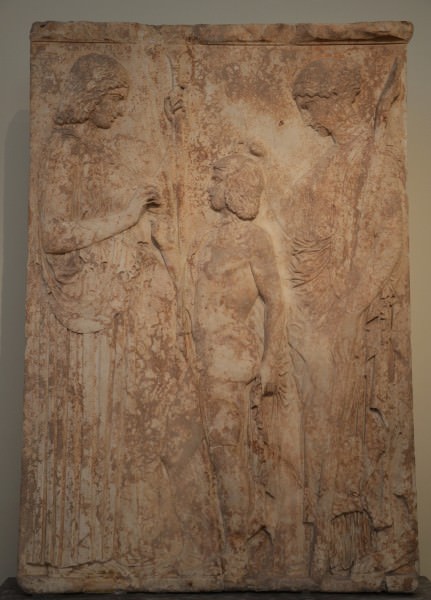
Eleusinian votive relief
THE ELEUSINIAN MYSTERIES
The famous Mysteries of Demeter and Persephone held at Eleusis are just that, a mystery, as the initiated were forbidden from revealing any of the details of the ceremonies involved. We know that from the 6th century BCE, the ceremonies were held twice a year. The first step in the initiation process was known as the "Lesser Mysteries" and held every spring. The more important "Great Mysteries" were held in the autumn over nine days. Only Greeks could be initiated, although this was later expanded to include Roman citizens.
We also know details of some of the outdoor activities and that ceremonies were held under torchlight. There was a procession led by the priestess of Demeter along the Sacred Way from Eleusis to the agora of Athens and another return procession led by a symbolic chariot of Iacchus. There were ritual and communal cleansing and purification ceremonies carried out in the sea at Phaleron, the representation or re-enactment of the myths involving the two goddesses, animal sacrifices (pigs), and the interpretation of sacred texts by priests, the mystagōgoi. There was also probably drinking, music, dancing, and general revelry involved (as with many other such cults in Greek religion ) as attested by pottery scenes of the rites which show initiates holding the "bacchus" or sacred rod. Closely associated with fertility and agriculture, the Mysteries probably brought worshippers good fortune and the promise of a better after-life.
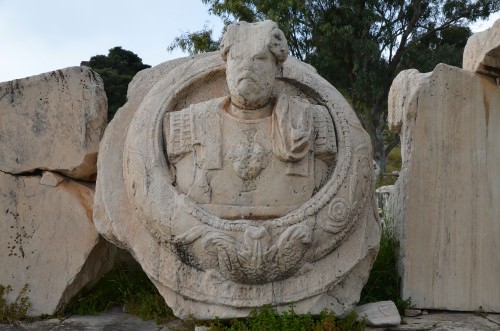
Cuirassed Bust of a Roman Emperor from Eleusis
ARCHAEOLOGICAL REMAINS
The site today is dominated by the large trapezoid Roman court (56 x 54.5 metres), which has a marble slab paving and was the most important structure at the site, the Telesterion. First built in Mycenaean times, the building was rebuilt many times.Today's remains date to the 5th century BCE in plan and later Roman modifications following the destructive fire in 170 CE.We know that there were six entrances, a portico and 14- column stoa, and the upper floor originally had 42 columns. The encircling eight tiers of seats and column bases survive to give a good idea of the original floor plan.
The Greater Propylaea of Eleusis was a copy of the central portion of the monumental entrance to the acropolis of Athens. On the south side of the sanctuary, it had five doorways and was the main entrance. It had a flight of six steps leading to two porches with a façade of six Doric columns on each side and an inner vestibule with six Ionic columns. Decoration was provided via a frieze of triglyphs and metopes and a pediment showing the bust of an emperor (Hadrian, Antoninus Pius or Marcus Aurelius but too weather-worn to identify with certainty) which can still be seen at the site.
Only the foundations and restored parts of the ten column portico remain of the Northeast stoa. Some substantial pieces of the east triumphal arch, built using Pentelic marble, also survive which was once 16 metres high, 4.85 metres wide, and a replica of Hadrian's arch in Athens. Of the opposite arch on the western side only the base and a few fragments remain. Foundations of other structures still present include the northwest stoa, two exedra, the Temple of Artemis and Poseidon, the outdoor altars of Artemis and Poseidon, storage rooms and silos, treasury buildings, and the polygonal stone Kallichoron well. Parts of the Pisistratan wall also survive showing foundations, a section of flat stones, a layer of polygonal blocks of blue-grey Eleusinian stone, and a top layer of bricks.
Surviving art and sculpture from the site include relief panels showing Demeter and Persephone, clay votive plaques depicting rites from the Mysteries, a 5th century BCE statue of a fleeing Persephone from the pediment of the Sacred House, a caryatidfrom the Lesser Propylaea, a 2nd century CE life-size statue of Antinous, and a marble votive pig, all of which can be seen in the Eleusis Museum.
Veii › Ancient History
Definition and Origins
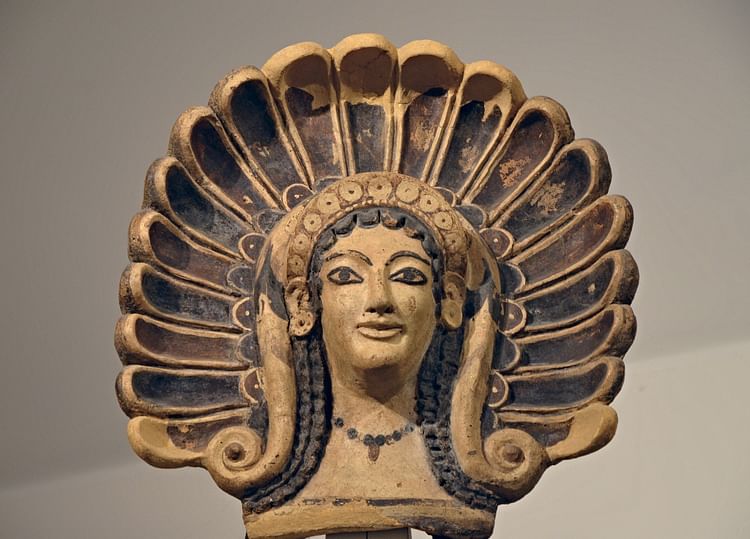
Veii (modern name: Isola Farnese, in Etruscan : Vei), was an important Etruscan town located near the west coast of central Italy. Lying just 16 km north of Rome, it was the most southerly of the major Etrurian settlements. The prosperity of Veii in the 6th and 5th century BCE is attested by the construction of a sizeable Etruscan temple, the Portonaccio Temple, which was decorated with large terracotta figure sculptures, one of which, a confidently striding Apollo, is celebrated as a masterpiece of Etruscan art. Veii was a long-time rival of nearby Rome and suffered a legendary 10-year siege from 406 BCE. When it finally fell, the city was destroyed but not obliterated as it had a second, more modest life as a small Roman town well into Late Antiquity.
EARLY SETTLEMENT
Evidence of habitation at the site dates back to the Bronze Age and indicates that Veii was an important settlement of the Villanovan culture (1000-750 BCE), a precursor to the Etruscan. Archaeological evidence shows that these people lived in wooden circular huts built over a shallow trench and with thatched roofs. There were, as yet, no specialised manufacturing centres, but each household would have produced their own textiles from wool, as attested by frequent finds of such paraphernalia as spools and loom weights. Large cemeteries from this period have rock-cut pits within which was placed a funerary urn and other votive offerings. Some later tombs have trenches or benches where a body was laid to rest. The tombs were rich in pottery finds, including the locally produced geometric wares and large numbers of Greek vessels, perhaps from Greece itself or colonies in Magna Graecia.
A THRIVING ETRUSCAN CITY
Vast numbers of Greek vases attest to Veii's contact with the wider world and its role, as with other Etruscan centres, as a significant trading city. The earliest Greek vessels come from the Fontalini cemetery and date to the 8th century BCE. These show that first contact was with the Euboeans of Greece. There are also examples of Phoenician pottery. Veii had its own thriving workshops producing figure sculpture, bronze work (eg horse bits, braziers, weapons, and rectangular fans), and pottery such as the distinctive Etruscan bucchero wares with their shiny black finish. Local artists achieved some renown, a notable figure being one named Vulca, who was commissioned to provide sculptures for Rome's Temple of Jupiter.
VEII'S PROSPERITY CAME FROM SALT PANS, AGRICULTURE & ITS CONTROL OF SHIPPING TRAVELLING UP THE TIBER RIVER.
7th and 6th century BCE tombs are constructed of steps leading down to an open area surrounded by niches. The design, known as area scoperta, is unique to Veii. Finds within the tombs of this period are more modest than those from contemporary coastal Etruscan sites, perhaps indicating the latter were more prosperous due to their better trade connections.Veii does have some of the earliest Etruscan wall paintings, though, including the Tomba delle Anatre named after the five ducks painted on one wall. The tomb dates to between 680 and 660 BCE and is painted, as other early tombs at Etruscan sites, to resemble the inside of a tent, an earlier funerary practice of this culture.
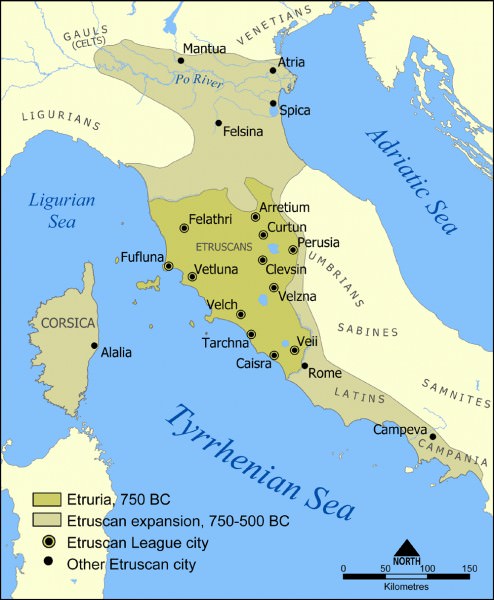
Etruscan Civilization
By the late 6th century BCE Veii begins to establish itself as an important regional town as indicated by an increase in overall size, larger buildings with terracotta decoration, and a greater concern for town planning. Two notable temples were dedicated to Vei/Ceres and to Juno Regina, Veii's patron goddess. A wide central avenue dominated a regular layout of secondary streets. Water supply was regulated via canals and tunnels ( cuniculi ), the largest of which is the 70 m long Ponte Sodo. The town's prosperity came from the production of salt from the pans at the mouth of the River Tiber, agriculture, and its control of shipping travelling upriver to the interior of Etruria.
Veii was a member of the Etruscan League, a loose confederacy of 12 (or perhaps 15) Etruscan towns. They included Cerveteri (Cisra or Caere), Chiusi, Populonia, Tarquinia (Tarchuna), Vulci (Velch) and Volterra. Very little is known of this league except that its members had common religious ties and that leaders met annually at the Fanum Voltumnae sanctuary near Orvieto (exact location as yet unknown).
THE PORTONACCIO TEMPLE
Just outside the city stood the sanctuary of Portonaccio with its large temple, subsidiary treasury buildings, free-standing altar, stone tubular drain for the pouring of libations, and a sacred rectangular pool lined with clay. These all date to c. 510 BCE.Perhaps dedicated to Menrva (the Etruscan version of Athena / Minerva ), the temple was of Etruscan design with the typical side entrance as well as front steps. It was built on an almost square base of volcanic tufa blocks measuring 18.5 m along the sides. The facade had columns which created a veranda in front of the temple building. The ends of the roof carried terracotta antefixes depicting gorgons, maenads, and river gods, while large terracotta statues stood on saddle-like tiles along the roof's central ridge. These included Leto carrying her young son Apollo, Hermes, and Hercules wrestling the Hind of Keryneia.
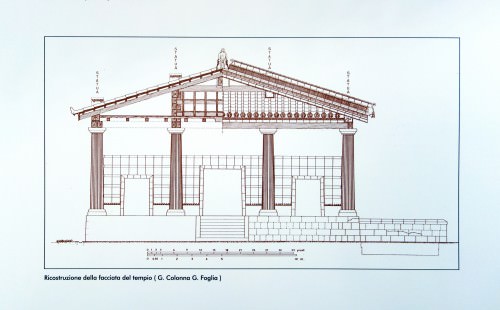
Etruscan Temple Reconstruction
One of the temple's roof statues, a fine life-size standing figure of Apollo wearing a flowing robe and striding forth purposely, can today be seen in the National Etruscan Museum of Villa Giulia in Rome. The interior of the temple was decorated with painted terracotta relief panels showing scenes from mythology. Inscribed votive offerings at the site indicate that the sanctuary was visited by pilgrims from across central Italy who sought to consult the oracle there.
DECLINE & ROMAN CONQUEST
A period of decline set in for Veii from the mid-5th century BCE as control of the lucrative local trade routes fell into the hands of Sicily 's rising power Syracuse. Even worse was to come, however, when the Etruscan's southern neighbours started to show more territorial ambition too: the Romans were coming, and Veii was to be their first victim. It was at this time, too, that the city constructed fortification walls punctuated with several gates, roads to which connected Veii with other Etruscan towns.
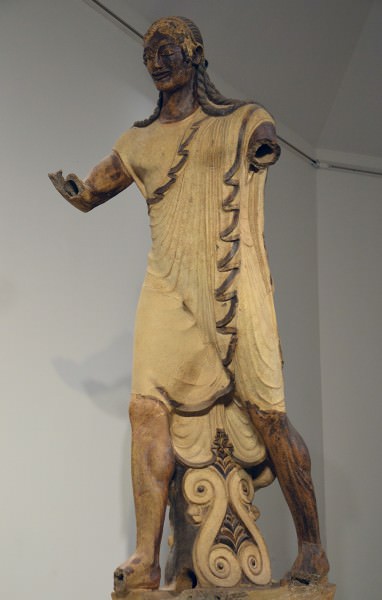
Apollo of Veii
The Romans would exploit the lack of political and military unity between the Etruscan League members and eventually take over all of the Etruscan cities. Veii, being especially close, was the first to feel the brunt of Rome's might as the Eternal City set off on the road to conquering the Mediterranean. No fewer than 14 wars are recorded between the two cities, and relations soured further around 437 BCE when Lars Tolumnius, the king of Veii, murdered four Roman ambassadors. Veii called for assistance from the League, but perhaps because the city was still a monarchy while most other Etruscan cities were now run by an aristocracy, the more powerful members declined to send aid to fight the Romans. The subsequent Veientine War (437-435 BCE) saw Lars killed in single combat by the consul Aulus Cornelius Cossus.
Finally, in 406 BCE, Veii was besieged (incredibly for 10 years), then sacked when the Romans tunnelled into the city, and incorporated into Roman lands in 396 BCE. The statue of Juno Regina was whisked away from her temple by the general M. Furius Camillus and set up in a new home in Rome. The Romans had immediately doubled their territory and the Etruscanswould rue the day they had not stood together to face this common and ruthless enemy. Meanwhile, the remnants of Veii, those who escaped the dreadful fate of being sold into slavery, were permitted to form a small town which eventually became a modest Roman municipium in 2 BCE with the title of municipium Augustum Veiens. Although never regaining its former glory, Veii continued to function as a town of reasonably well-off Roman residents into the 3rd century CE and beyond.
MAP
LICENSE:
Article based on information obtained from these sources:with permission from the Website Ancient History Encyclopedia
Content is available under License Creative Commons: Attribution-NonCommercial-ShareAlike 3.0 Unported. CC-BY-NC-SA License